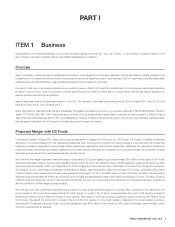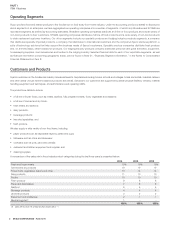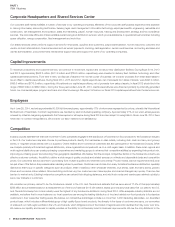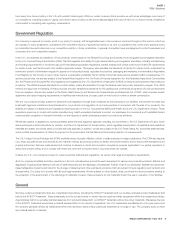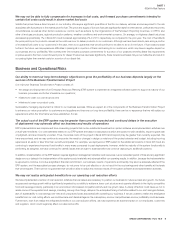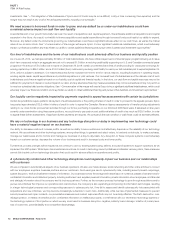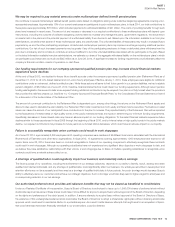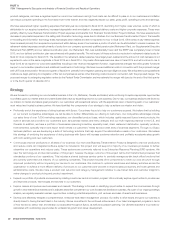Sysco 2014 Annual Report Download - page 22
Download and view the complete annual report
Please find page 22 of the 2014 Sysco annual report below. You can navigate through the pages in the report by either clicking on the pages listed below, or by using the keyword search tool below to find specific information within the annual report.SYSCO CORPORATION-Form10-K10
PARTI
ITEM1ARisk Factors
We may not realize the full anticipated bene ts from our category management initiative
We are in the midst of deploying our category management initiative which encompasses a rigorous process whereby we use market data and customer
insights to optimize the product assortment available to our customers, strengthen strategic relationships with our suppliers, drive product innovation and
increase our sales and pro t margins. If our sales associates are not able to effectively gain acceptance of the new product assortment from our customers
or are not able to absorb the signi cant administrative and process changes required, then we may not be able to successfully execute the category
management initiative in the timeline we anticipate and we may not capture all of the nancial and other bene ts that we anticipate.
Conditions beyond our control can interrupt our supplies and increase our product costs
We obtain substantially all of our foodservice and related products from third-party suppliers. For the most part, we do not have long-term contracts
with our suppliers committing them to provide products to us; however, we believe the number of long-term contracts will increase as we progress with
our category management initiative. Although our purchasing volume can provide bene ts when dealing with suppliers, suppliers may not provide the
foodservice products and supplies needed by us in the quantities and at the prices requested. We are also subject to delays caused by interruption in
production and increases in product costs based on conditions outside of our control. These conditions include work slowdowns, work interruptions, strikes
or other job actions by employees of suppliers, short-term weather conditions or more prolonged climate change, crop and other agricultural conditions,
water shortages, transportation interruptions, unavailability of fuel or increases in fuel costs, product recalls, competitive demands and natural disasters
or other catastrophic events (including, but not limited to food-borne illnesses). Further, increased frequency or duration of extreme weather conditions
could also impair production capabilities, disrupt our supply chain or impact demand for our products. Input costs could increase at any point in time for a
large portion of the products that we sell for a prolonged period. Our inability to obtain adequate supplies of foodservice and related products as a result
of any of the foregoing factors or otherwise could mean that we could not ful ll our obligations to customers, and customers may turn to other distributors.
Adverse publicity about us or lack of con dence in our products could negatively impact our reputation
andreduceearnings
Maintaining a good reputation and public con dence in the safety of the products we distribute is critical to our business, particularly to selling Sysco Brand
products. The Sysco brand name, trademarks and logos and our reputation are powerful sales and marketing tools, and we devote signi cant resources
to promoting and protecting them. Anything that damages our reputation or the public’s con dence in our products, whether or not justi ed, including
adverse publicity about the quality, safety, sustainability or integrity of our products or relating to activities by our operations, employees, suppliers or agents
could tarnish our reputation and reduce the value of our brand, and could adversely affect our revenues and pro ts.
Reports, whether true or not, of food-borne illnesses (such as e-coli, avian u, bovine spongiform encephalopathy, hepatitis A, trichinosis, salmonella, listeria
or swine u) and injuries caused by food tampering could also severely injure our reputation or negatively impact the public’s con dence in our products.
If patrons of our restaurant customers become ill from food-borne illnesses, our customers could be forced to temporarily close restaurant locations and
our sales and pro tability would be correspondingly decreased. In addition, instances of food-borne illnesses or food tampering or other health concerns
(even those unrelated to the use of Sysco products), or public concern regarding the safety of our products, can result in negative publicity about the food
service distribution industry and cause our sales and pro tability to decrease dramatically.
Damage to our reputation and loss of brand equity could reduce demand for our products and services. This reduction in demand, together with the
dedication of time and expense necessary to defend our reputation, will have an adverse effect on our nancial condition, liquidity and results of operations,
as well as require additional resources to rebuild our reputation and restore the value of our brand. Our business prospects, nancial condition and results
of operations could be adversely affected if our public image or reputation were to be tarnished by negative publicity including dissemination via print,
broadcast or social media, or other forms of Internet-based communications. Adverse publicity about regulatory or legal action against us could damage
our reputation and image, undermine our customers’ con dence and reduce short-term or long-term demand for our products and services, even if the
regulatory or legal action is unfounded or not material to our operations. Any of these events could have a material negative impact on our results of
operations and nancial condition.
If sales to our locally-managed customers grow at a lower rate than sales to our corporate-managed customers,
our operating margins may decline and our corporate-managed customers will increase their proportion of our total
sales, thus subjecting us to greater risk if we lose one or more of these customers and possibly enabling these larger
customers to exert greater pressure on us to reduce our prices and/or expand our services
Our sales to corporate-managed customers have generally grown at a faster rate than our sales to locally-managed locations. Gross margin from our
corporate-managed customers is generally lower than that of our locally-managed customers because we typically sell higher volumes of products to
these customers and provide a relatively lower level of value-added services than we do to locally-managed customers. If sales to our locally-managed
customers do not grow at the same or a greater rate as sales to our corporate-managed customers, our operating margins may decline.
Moreover, if sales to our corporate-managed customers increase at a faster pace of growth than sales to our locally-managed customers, we will become
more dependent on corporate-managed customers as they begin to represent a greater proportion of our total sales. Additionally, the loss of sales to the
larger of these corporate-managed customers could have a material negative impact on our results of operations and nancial condition. Additionally, as
a result of our greater dependence on these customers, we could be pressured by them to lower our prices and/or offer expanded or additional services



